Lesson study
Case study 1 /2:
K2 lesson on more than, less than.
What I learn :
1. When we are comparing, use identical items.
(So that children will focus on comparing more/less and not the properties of the items.)
2. Placing items in a line/ cluster?
(placing items in a line is at an easier level compare to placing items in a cluster.)
3. Use different representation (such as graph chart) to show more / less.

Besides, I also learn that we have to take note of :
-The seating arrangement during activities
-Giving quality instructions
-Asking questions to stimulate thinking
-The design of task to provide differentiated instructions to cater to different needs
-Use of manipulative/ materials
-Sequence of lesson
Case study 3:
Ms Peggy's lesson
Three things i would take away from her lesson:
1. The way to ask questions to stimulate children's thinking.
2. To take note of the different ability of the children and come up with differentiated instructions (using the same activity) to engage all the children.
3. Using of open ended materials.
I love the way Ms Peggy asked questions and using all opportunities as "teachable moment". In addition, I can see that the children were really engaged and learning math through a fun way. I will definitely take note of all these good practices! :)
Fun with 5 unifix cubes - Learning the idea of conservation of number.

This is a great hands-on activity to get children to be creativity and at the same time learn the idea of conservation of number!



